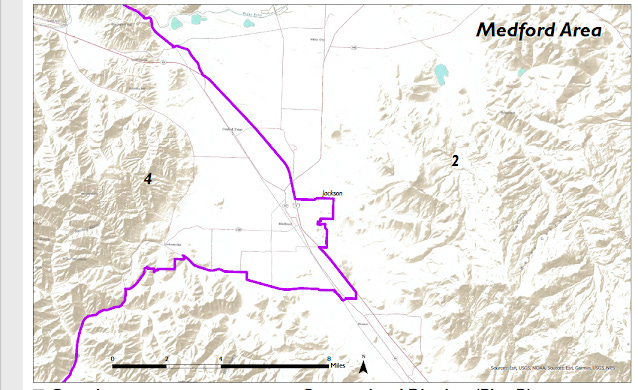First Drafts of New Districts Shows Evidence of Partisanship
Both Democratic and Republican maps reveal some partisan aspirations. But, when it comes to redistricting, there are few easy answers.
Both the Democrats and Republicans recently offered their drafts for how to draw Oregon’s congressional districts. One elects five Democrats. The other elects three or four Republicans.
Here is Map A, preferred by Democrats.
Here is Map B, favored by Republicans.
Out-of-state readers may not notice the craft and partisan intention embedded in the maps. They might (optimistically) assume that both sides aspired to produce compromise maps, rather than stake out more extreme positions from which to better negotiate. In some cases, both maps appear to illustrate fair play at work, in the form of big chunks of contingent land, and borders that generally follow existing county lines. Nothing appears overtly partisan. Those appearances are reality, in some cases. And, for all the partisan positioning that did occur, things could be much worse.
Below are examples of what both parties managed to avoid: districts drawn with no pretense of reasonableness or fairness. The districts outlined below are actual districts in other states, drawn to pick and choose voters across existing jurisdictions, communities, and media markets.
Both of Oregon's maps look great in comparison. And, despite the faults of the maps, at least both sides applied straightforward rationales to their respective outlines.
There is a simple logic underlaying Map A. The three-county Portland metropolitan area has about half the state's population of 4.2 million people. In Oregon and the U.S. generally, city people expect more from government than do rural people and vote more Democratic. Map A splits the metropolitan area as the center of a pie for four districts, sharing the Democratic wealth among the four districts.
There is a district for west Portland and its suburbs out to the coast.
Another for southwest Portland and its suburbs, including the west side of the wine country of the Willamette Valley down to Salem.
One for southeast Portland down through the east side of the Willamette Valley.
And, finally, there is a District for east Portland and its suburbs out along the Columbia River and its ports, and then down to Portland's recreation area of Bend.
Four districts, all mixing red and blue, urban and rural.
Then there is a southwest Oregon District represented by Peter DeFazio, number four on the map. It is a heavily forested District, anchored by its only large city, Eugene-Springfield, home of the University of Oregon. The theme here is the highly productive western Oregon forests, plus the major market center for it, and a university.
The final and fifth district in Map A is the very rural, agricultural and timber district of Eastern Oregon, one that swings west to include my home in Jackson County. My county has 220,000 people, and we are needed to get the necessary population numbers for the district. Jackson County is more urbanized and moderate in its voting than most of the rest of the proposed District. The recent COVID outbreak that is swamping Medford hospitals may be indicative of our being part of that Eastern Oregon district. Like the other rural counties, and unlike the Portland metropolitan area, nearly half of Jackson County residents declined to be vaccinated. We vote--and get hospitalized for COVID--like more Republican parts of the country.
The partisan craftsmanship in Map A is embedded in the fact that Republican-heavy Eastern Oregon retains its own district, thereby "wasting" Republican votes--i.e. grouping all the Republicans in one uncompetitive district.
Another bit of craftsmanship is dividing Portland and its blue suburbs to include farm and coastal areas that are purple or red, carefully spreading the Democratic wealth and creating mildly (but reliably) Democratic districts.
Finally, in Map A, DeFazio's troublesome SW Oregon forest district loses two Republican timber counties, Douglas and Josephine. That tilts the district back toward more university and less timber, and therefore more Democratic.
Map B has a different logic. First off, it deals with DeFazio's swing district by removing moderate Benton County, keeping the Republican timber counties of Douglas and Josephine. Map B then divides Jackson County in half, and adding the more Republican part of it to DeFazio's district. Pow!
The divide puts the south-county Democratic part of Jackson County into the still-intact bright red Eastern Oregon District, where they will be thoroughly outvoted and do no harm. This division of Jackson County and transfer of Republicans to DeFazio’s district is where the hand of the partisan craftsman is most evident.
Map B's logic in the populous Portland and Willamette Valley is to create a single bright blue Portland district. There is arguable justification for this: Why wouldn't Portland want its very own House Member, someone who wins with 75% of the vote, someone free to be as "Portland" as desired? The western suburbs of Portland are also somewhat blue, so Map B creates a tight second District for Beaverton and its surroundings. Two blue districts. The map then creates two Willamette Valley districts that mix moderate cities with rural areas, creating swing districts, but with a Republican lean.
Net is four Republican seats out of six, most years.
There is a defensible non-partisan reason to say Map B is fair and reasonable. Eastern Oregon is bright red; Portland is bright blue. Even-Steven. West Portland and its suburbs are probably blue, so they get another Representative--a generous act of bi-partisanship. DeFazio has a fighting chance because he is so powerful a representative, as Chair of the Transportation Committee overseeing infrastructure, so maybe Democrats get three Representatives…if DeFazio can hang on. Let the voters decide. Plus, isn't it the interest of good government for there to be more swing districts, and isn't that what is proposed for the two Willamette Valley Districts?
Arguably, there is no chicanery here; the districts are big, contiguous hunks, reasonable on their face. To get the numbers right, sure, some counties needed to be split, and why not Jackson County, and why not have a Republican area be part of the Eugene-anchored district? After all, Democratic Ashland and the south county are farther down I-5 and just outside the carve-out, so it is just an accident of geography, not politics.
I prefer Map A. I don't deny that I would prefer to elect more Democrats, and that is part of it. Plus, I prefer that DeFazio represent a swing district with a light Democratic tilt, not try to represent a strongly Republican one. If DeFazio gets defeated I would prefer it be because voters changed their minds about him, not that map-makers changed voters out from under him.
Moreover, Map A does not divide my county. Map B does. My house would be in one district, my farm in another. Jackson County is a long-established polity, with medical, governmental, and media institutions servicing the area as a unity. As the intact population center of the proposed 2nd district in Map A, it is reasonable to think at some point a local person--most likely a Republican, of course--would represent it. A Republican politician who rises to prominence in Jackson County would likely be somewhat moderate in policy and messaging. The current representative, from the NE corner of the state and district, caught up in the enthusiasm of overturning the 2020 election to keep Trump in office, voted to void the Pennsylvania vote. Possibly a Jackson County Republican would know better.
Neither of these maps are final. Both could be defended with a straight face, arguing from principle, denying partisan interest--and that is what we will hear, partisan interest denied. The maps are reasonable and fair!! Oregon's two maps demonstrate what makes re-districting so consequential and so hard.









I’m shocked! Peter Sage agrees with the Dems plan.
There are few more partisan “commentators” than Peter. He suffers from an acute case of what cognitive psychologists call “My Side Bias”.
I use his work when I teach critical thinking classes as an example of how NOT to approach an issue.
What Peter represents is exactly the opposite of “The Oregon Way Forward”. His comments may be interesting and occasionally enlightened yet they all ultimately have their source in a deeply rooted prejudice that epitomizes ugly partisanship.
Interesting take
One pet peeve of mine, Beaverton isn’t even the largest city in Washington County, Hillsboro is. WashCo has changed a lot in the last 20 years.